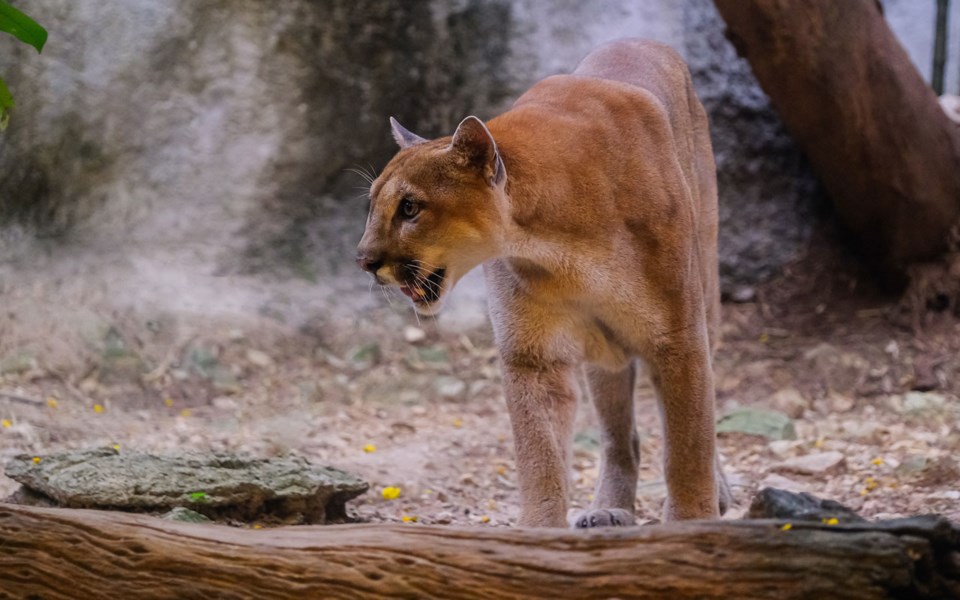When the Conservation Officer Service (COS) had to come to Angus Cormack’s Sweetwater Lane Farm on Lil’wat Nation territory to ultimately trap and destroy a cougar, he almost immediately started thinking about how the situation could provide some benefit.
After being struck by the majesty of the animal, Cormack reached out to the COS to investigate the possibility of gifting the cougar—which had killed one of his donkeys—to the Lil’wat Nation. Cormack had never previously seen a cougar and hopes that providing people the opportunity to appreciate a taxidermy version will allow people to take in its aura.
“To be able to see one like that was really awe-inspiring and it was really, really sad … that it had to be destroyed,” he to Pique of the fully grown, healthy tomcat.
“I knew roughly how big they were, but the size and strength of the animal surprised me,” he added later.
Ts’zil Learning Centre director Mason Ducharme said the plan is to place the cougar in the s7ístken Hall.
“We’re really excited to display it,” he said. “It will be available for the whole public to come look at it.”
To cover the taxidermy costs, Cormack has launched a GoFundMe, which had passed $2,000 of its $5,000 goal—the estimated cost of the work—by March 2.
Cormack said the encouragement he’s received on social media has been welcomed, though he stressed that there will need to be more dollars put forward to make the project a reality. As of now, the funding will need to be in place by the end of the month.
“There’s been a lot of likes on the post but not a lot of people clicking and actually donating even five or 10 bucks,” he said. “We can’t keep the hide in Conservation Officer storage indefinitely.
“If I can clear the $4,000 mark, I can easily get to $5,000,” he added.
Sightings in the area
Though Cormack’s first interaction with the cougar came on the night it was trapped, Feb. 10, there had been numerous sightings and around the farm, not far from the Owl Creek Recreation Site, for weeks prior.
Cormack said that he would not let his son walk to the bus alone because of the danger.
Then, on that mid-February day, Cormack spotted his donkey laying down in the minus-15 weather, which he thought was odd.
“I went over and it was immediately obvious what had happened,” he said.
Cormack called COS and said they were onsite for roughly six hours learning more about the situation.
“They were very, very meticulous in determining the best course of action, determining that trapping it was the best option,” he said. “By about 5 p.m. that night, the traps were set.
“By 7 p.m., there was a cougar in the trap.”
Responding Conservation Officer Kent Popjes said that the cougar’s increasingly aggressive activity left the service officers with no other options.
“There were a number of cougar sightings in the area over the last number of weeks, so it was clear that it had been seen by a number of people and was getting bolder,” he said. “After it kills and has success like that, it’s going to repeat that. We’ve seen that in the past. It will kill other livestock, without question.”
An act of reconciliation
For Ducharme’s part, he was appreciative not only to be offered the gift but also that the animal will remain in the area.
“It’s pretty awesome when people that aren’t from our community recognize that our community is still here,” he said. “That is an individual’s approach to reconciliation. We hear about governmental approaches, but this feels like this is an independent, individual approach.”
Ducharme added he hopes to have a ceremony down the line to unveil and celebrate the cougar.
Cormack, who originally hails from Australia—another colonized land—said he has reconciliation efforts in mind when considering his place in the world.
“If that’s a nice reconciliation gift in Lil’wat’s eyes, then for me, that would be the nicest thing that I could hear from them,” he said.
Popjes, meanwhile, noted that COS will often offer First Nations members animal remains for meat or other uses if appropriate to do so. He noted that a taxidermy cougar that also was destroyed is on display at Squamish Nation’s Totem Hall.
Popjes added that the COS’ standard procedure is to put an animal’s remains back into nature to decompose naturally and feed other animals, provided it was not injected with drugs such as tranquilizers.




